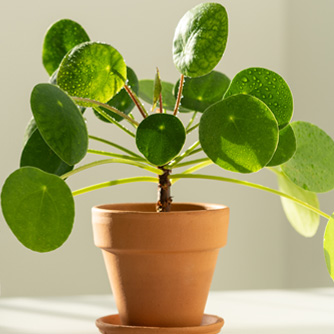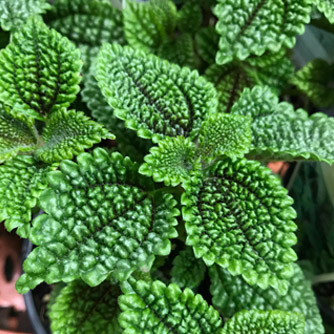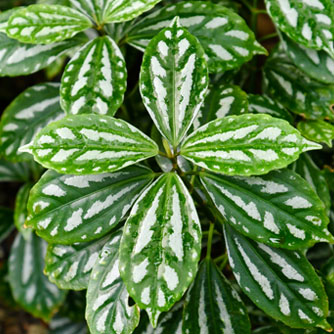Pilea
BackPilea make ideal indoor plants thanks to their incredibly diverse foliage types and relatively easy-care nature. Now you’re probably scratching your head thinking you’ve never heard of this plant genus, but if you know the aluminium plant or Chinese money plant then you already know some pileas!
Most pilea originate from tropical, subtropical and warm temperate climates, which makes them very adaptable to growing inside. Whilst they may flower for you, the flowers are usually small and insignificant, but don’t let that put you off pileas. These plants are well worth growing for their interesting foliage alone.
Our Favourite Pileas
Chinese Money Plant (Pilea peperomioides): Possibly the most famous pilea with its distinctive lily pad shaped leaves perched on the ends of a long thin stem. Hugely popularised by social media in recent years, they were once extremely expensive to buy, but are thankfully totally affordable now.
Aluminium Plant (Pilea cadierei): This pilea gets its common name from the silvery markings on its oval shaped green leaves. It can grow up to 30 cm tall with a bushy habit, but if you prefer a smaller form, look for Pilea cadierei ‘Minima’, which only grows to 15 cm.

The popular Chinese money plant (Pilea peperomioides)
Pilea glaucophylla: A groundcover pilea with small grey leaves produced along wiry reddish stems. When kept in a pot it will quickly trail over the sides. Plant in a hanging basket or elevated pot to fully appreciate its beauty. Commonly sold as ‘Silver Sprinkles’ or Silver Sparkles' and sometimes labelled Pilea glauca - just to add to the confusion!
Pilea mollis ‘Moon Valley’ – this stunning pilea has heavily textured foliage which is bright green and often with contrasting darker veins. It produces upright growth to about 30 cm high whereas the original species tends to be more of a trailing plant.
How to Grow Pilea
Like most houseplants, pileas should be positioned in bright light but out of direct sunlight. Their soft leaves can burn if exposed to direct light, especially if it’s the harsh afternoon light. They will also tolerate lower light levels but growth will be slower and they may drop leaves. Remember to turn plants often to keep the plant balanced, as you’ll see, they like to grow towards the light.
Pot up in a premium potting mix and water in well with OCP eco-seaweed to help reduce transplant shock. If you're a bit of an "overwaterer" with your indoor plants, then blend some perlite into the mix to help provide extra drainage.

The amazing textured leaves of Pilea mollis 'Moon Valley'
Water regularly during the warmer months when plants are actively growing but always allow the top few centimetres (2.5-5 cm) of soil to dry out before watering again. These guys don’t want to be overwatered. Reduce watering in winter as plants aren’t actively growing. Generally pileas don’t need high humidity levels and should happily grow indoors without any special treatment.
With the upright growing types, like the Chinese money plant, the older leaves will yellow and fall off leaving expose stems. As long as the rest of the plant is healthy and the other leaves are lush and green, there is nothing to worry about. If however the plant is weak and spindly looking then it’s a sign it needs to be grown in more light.
In tropical, subtropical and warm temperate climates pilea can be grown outside. This can be in pots in a protected spot, out of direct sunlight or directly into garden beds that receive bright filtered light. Ensure the soil is well-draining and improved with compost and organic matter prior to planting.
Fertilising and Maintenance of Pilea
During the warmer months feed pilea with OCP eco-aminogro and OCP eco-seaweed every four weeks. If you want faster growth then increase the frequency to once a fortnight. Plants can be repotted every 1-2 years as they fill out their pots and exhaust the potting mix.
If the tall growing pileas become leggy they can be pruned back during the warmer month. New growth will appear on the remaining stems and also at the base of the plant. The clippings can be used to easily propagate new plants (see below).

Pilea glaucophylla often sold as 'Silver Sprinkles' or 'Silver Sparkles'
Propagating Pilea
Pilea propagate fairly easily and are often referred to as the ‘friendship plant’ because of how easy they are to share with friends.
The Chinese money plant produces little offsets called pups at the base which can be removed during the warmer months. Carefully remove the plant from its pot and use a clean sharp knife to cut away offsets. If the pup comes away with a root ball you can pot it up into fresh potting mix and water in with OCP eco-seaweed. If there are only a few root strands, run the pup under water to remove excess dirt and place in a jar of water. After 4-6 weeks roots will form. Once they’re 10-12 cm long you plant them into small pots.
Note that over time the remaining mother plant often develops a bare ‘woody’ stem with only a cluster of leaves at the top. If you don’t like this look then cut the stem in half (during the warmer months) and place the top section in a jar of water to root just like with the pups. Remember to continue to water the base stem as new shoots will form along its length.
Other pilea species can also be propagated by stem cuttings during the warmer months. Cut a 10-15 cm length of stem, ensuring there is a node near the base (a node is the bump along the stem where leaves form). Remove the lower leaves and place cuttings in a glass of water with the bottom node(s) submerged. Top up as needed and once roots are 10-12 cm long you can pot them up.

The aluminium plant (Pilea cadierei)
Pests and Diseases of Pilea
Pilea are generally trouble-free, but you may sometimes run into:
- Mealybugs – small white fluffy insects found along the stem and leaves and often in protected crevices. Treat with OCP eco-neem.
- Mites - tiny sap sucking pests which will cause the leaves to mottle and lose their greenness. Treat with OCP eco-neem at the first sign of trouble.
- Browning leaves and/or rotting stems – typically a result of over-watering. Pilea will not tolerate "wet feet" (wet feet is when the potting mix stays too wet for too long), so ensure the potting mix is well-draining and allow the top few centimetres of soil to dry before watering again.
- Leaf drop – a sign the plant is kept too wet or too dry. If the plant also looks stretched out or leggy then it probably needs more light too. Just remember it is normal for lower leaves to drop as they age so some leaf drop is to be expected.
- Fungus gnats – if you see these pesky guys flitting around your pilea then drench the potting mix with OCP eco-neem to control the larval stage. Repeat a week later to fully break the life cycle. Fungus gnats love moisture so also try to delay your watering if possible to keep the potting mix a bit dryer.

Pilea spruceana 'Norfolk'


